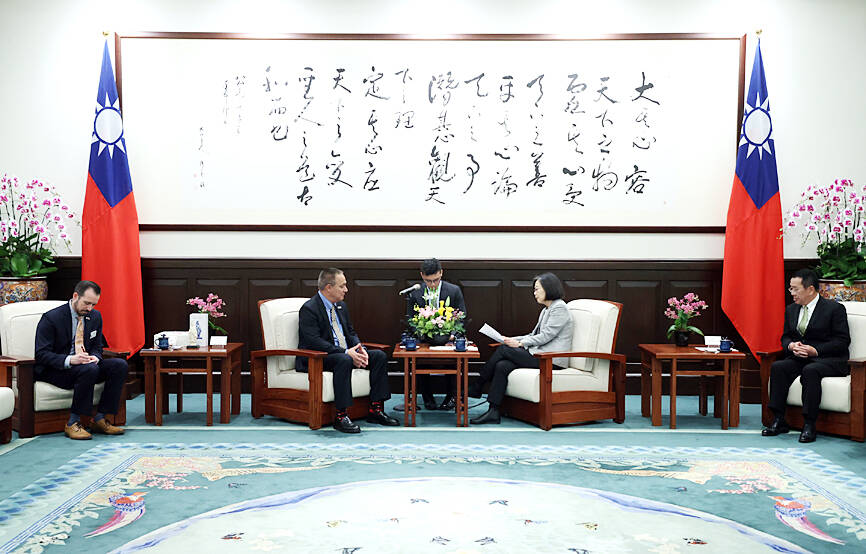Taiwan’s military would continue to conduct exchanges with the US to beef up joint operation capabilities, said the head of Taiwan’s navy, who is visiting the US.
Speaking to Taiwanese reporters on Monday while attending a maritime exhibition in Maryland, Navy Commander Admiral Tang Hua (唐華) said there is always room for further military exchanges and training between Taiwan and the US.
Such exchanges have to continue because times are changing, and the interoperability of the two sides’ forces would change as the two sides’ equipment and personnel evolve, he said.

Photo: CNA
Tang made the remarks when asked about Taiwan-US military cooperation on the sidelines of the Sea-Air-Space conference and exposition he is attending until today.
He is attending the expo with Wei Chung-hsing (魏中興), a defense attache at the Defense Mission in the US.
NATO defines “interoperability” as the ability of allies to act together coherently, effectively and efficiently to achieve tactical, operational and strategic objectives.

Photo: CNA
Specifically, interoperability enables forces, units and/or systems to operate together, allowing them to communicate and to share common doctrine and procedures, along with information about each other’s infrastructure and bases.
The conference in the US is being held by the Navy League of the United States, a national association with nearly 50,000 members who want a strong, credible US Navy, US Marine Corps, US Coast Guard and US Merchant Marine, it says on its Web site.
Meanwhile, Tang declined to answer when asked if he would be meeting with senior US defense officials during his stay.
Taiwan is launching a number of domestic shipbuilding projects and he is at the conference to look for potential cooperation opportunities and partners on these projects, Tang said.
Before attending the Maryland conference, Tang visited Hawaii, home of the US Indo-Pacific Command, for a Pacific Fleet change-of-command ceremony.
Senior Taiwanese defense officials, with the exception of the minister of national defense, regularly visit the US for such conferences.
In related news, Duane Sarmiento, commander-in-chief of the Veterans of Foreign Wars (VFW), yesterday in Taipei reiterated his group’s support for Taiwan during a meeting with President Tsai Ing-wen (蔡英文).
Sarmiento, who was elected in July last year to head the Missouri-headquartered VFW, told Tsai that the group planned to once again pass a resolution to call for continued support for Taiwan from the US Congress, the Presidential Office said in a statement.
He also expressed the hope that officials from the Veterans Affairs Council would get the opportunity to visit Washington for exchanges, the statement said.
It is the first time that Sarmiento has visited Taiwan, it said.
Sarmiento was accompanied by Ryan Gallucci, executive director of the VFW’s Washington office, it added.
In her remarks, Tsai thanked the VFW, a nonprofit veterans’ service organization, for its consistent support for Taiwan.
Tsai said that at the VFW’s national convention last year, at which she delivered opening remarks via videoconference, the group passed a resolution calling on the US government to deepen its partnerships with Taipei and assist Taiwan in strengthening its self-defense capabilities.
The solid ties between Taiwan and the US have been forged by friends in various domains, such as the VFW, which has established a “brotherhood alliance” with the Veterans Affairs Council, she said.
The VFW has long wielded significant influence on the US government’s veterans’ policy, Tsai said, adding that the government hoped that by exchanging best practices with the VFW, it could improve the welfare of Taiwan’s veterans and their families.
Tsai last month met a delegation in Taipei led by American Veterans national commander William Clark.

LONG FLIGHT: The jets would be flown by US pilots, with Taiwanese copilots in the two-seat F-16D variant to help familiarize them with the aircraft, the source said The US is expected to fly 10 Lockheed Martin F-16C/D Block 70/72 jets to Taiwan over the coming months to fulfill a long-awaited order of 66 aircraft, a defense official said yesterday. Word that the first batch of the jets would be delivered soon was welcome news to Taiwan, which has become concerned about delays in the delivery of US arms amid rising military tensions with China. Speaking on condition of anonymity, the official said the initial tranche of the nation’s F-16s are rolling off assembly lines in the US and would be flown under their own power to Taiwan by way

OBJECTS AT SEA: Satellites with synthetic-aperture radar could aid in the detection of small Chinese boats attempting to illegally enter Taiwan, the space agency head said Taiwan aims to send the nation’s first low Earth orbit (LEO) satellite into space in 2027, while the first Formosat-8 and Formosat-9 spacecraft are to be launched in October and 2028 respectively, the National Science and Technology Council said yesterday. The council laid out its space development plan in a report reviewed by members of the legislature’s Education and Culture Committee. Six LEO satellites would be produced in the initial phase, with the first one, the B5G-1A, scheduled to be launched in 2027, the council said in the report. Regarding the second satellite, the B5G-1B, the government plans to work with private contractors

MISSION: The Indo-Pacific region is ‘the priority theater,’ where the task of deterrence extends across the entire region, including Taiwan, the US Pacific Fleet commander said The US Navy’s “mission of deterrence” in the Indo-Pacific theater applies to Taiwan, Pacific Fleet Commander Admiral Stephen Koehler told the South China Sea Conference on Tuesday. The conference, organized by the Center for Strategic and International Studies (CSIS), is an international platform for senior officials and experts from countries with security interests in the region. “The Pacific Fleet’s mission is to deter aggression across the Western Pacific, together with our allies and partners, and to prevail in combat if necessary, Koehler said in the event’s keynote speech. “That mission of deterrence applies regionwide — including the South China Sea and Taiwan,” he

‘NARWHAL’: The indigenous submarine completed its harbor acceptance test recently and is now under heavy guard as it undergoes tests in open waters, a source said The Hai Kun (海鯤), the nation’s first indigenous defense submarine, yesterday began sea trials, sailing out of the Port of Kaohsiung, a military source said. Also known as the “Narwhal,” the vessel departed from CSBC Corp, Taiwan’s (台灣國際造船) shipyard at about 8am, where it had been docked. More than 10 technicians and military personnel were on deck, with several others standing atop the sail. After recently completing its harbor acceptance test, the vessel has started a series of sea-based trials, including tests of its propulsion and navigational systems, while partially surfaced, the source said. The Hai Kun underwent tests in the port from